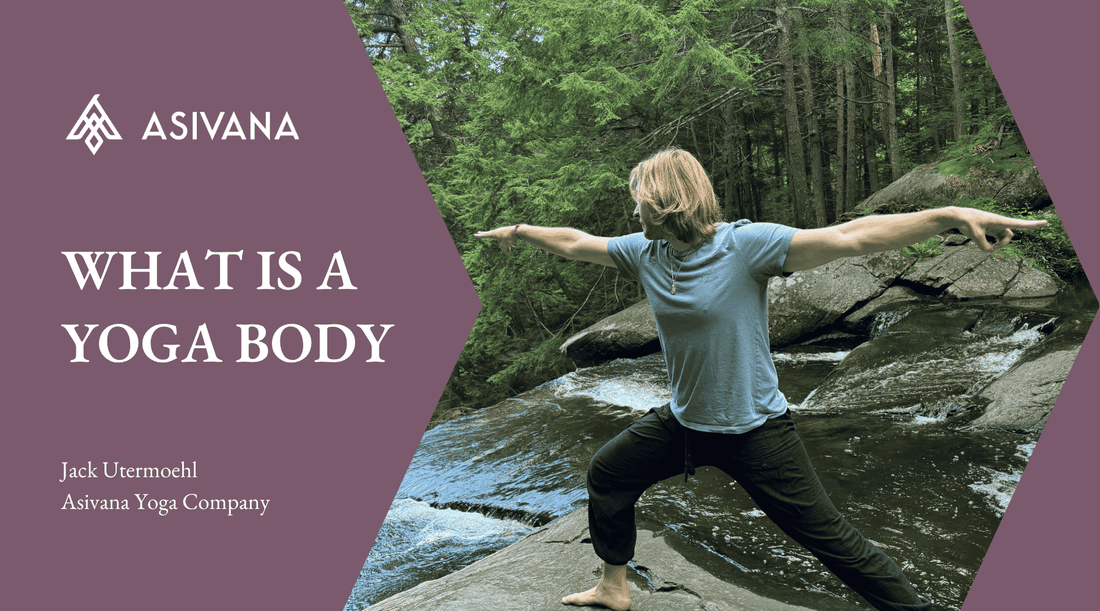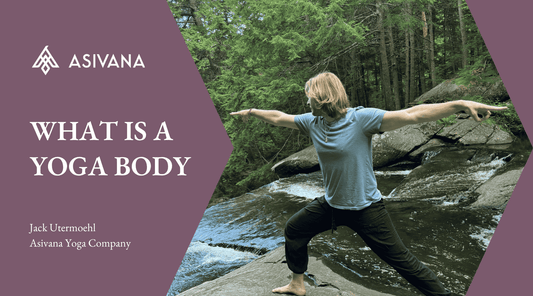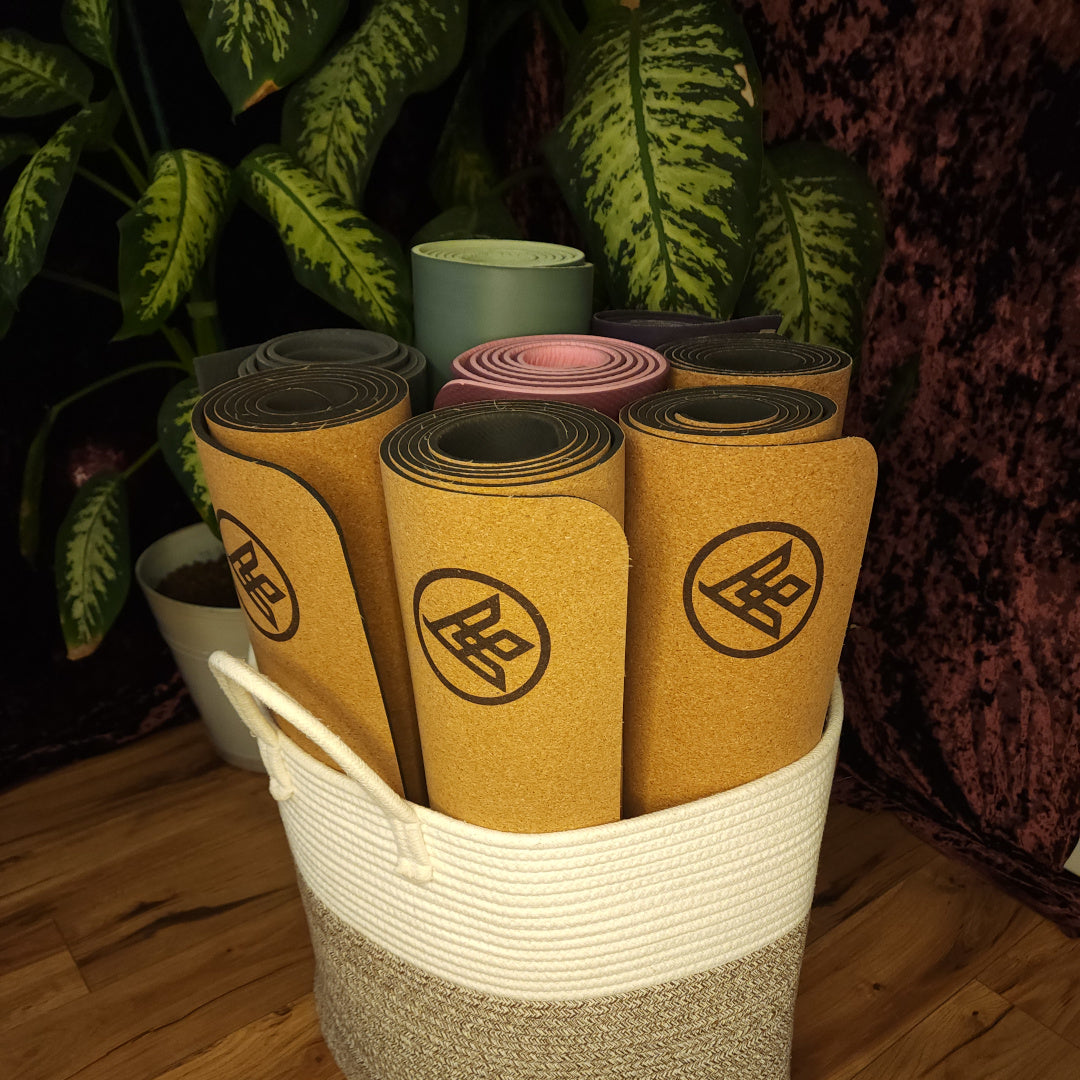
What Is a Yoga Body (And How Yoga Transforms Yours)
Jack UtermoehlYou’ve seen the images of slim, flexible bodies bent into perfect postures, glowing skin, toned abs. That’s what most people think of when they hear the phrase “yoga body.”
It’s a look that’s been packaged and sold, often without context by corporate businesses that are disconnected from the actual practice of yoga or are invested in capitalizing on yoga.
But that isn’t yoga. And that isn’t the only type of yoga body.
A yoga body isn’t something you get but rather it’s something you already have. If you have a body, you can do yoga. If you breathe, you can do yoga. The practice doesn’t require you to be thin, young, flexible, or strong. It only asks that you show up.
So what does yoga actually do for your body? How does it shape you, strengthen you, support you from the inside out?
Let’s explore the truth behind the yoga body. I'll answer what yoga does for your body so even though there isn't an exact "yoga body", there is a body that yoga shapes. And it all begins with doing yoga in your body as it is.

Yoga and Body Transformation
Can yoga really change your body?
It’s one of the most common questions people ask when they’re thinking about starting a yoga practice. And it’s a fair one. You want to know: if I commit to this, will I look different? Will I feel different? Will I start to become that elusive “yoga body” I see online?
The shirt answer is yes, yoga can absolutely change your body. The long answer, not always in the way you expect. While yoga is often gentle, it’s also powerful. Over time, the practice can lead to:
- Improved posture and spinal alignment
- Increased muscular strength using bodyweight resistance (calisthenics)
- Greater flexibility and range of motion
- Fat loss and body recomposition in combination with lifestyle changes
- Visible toning of arms, legs, and core
But the transformation goes deeper than what you see in the mirror. Many people report feeling:
- Lighter in their bodies and less weighed down by tension or fatigue
- More confident in how they move and carry themselves
- At home in their own skin being comfortable, aware, and grounded
- Emotionally clearer, less reactive, more connected
Here’s the Truth
You don’t need to look a certain way to do yoga or to be transformed by yoga. The changes happen on the mat in how you breathe, how you stand, how you notice yourself.
Sometimes you’ll notice the difference in your clothes. Sometimes it’s in your mood. Sometimes it’s just the way you catch yourself smiling in the mirror after practice, no reason needed.
So yes, yoga can change your body. But more than that, it can change your relationship to your body and that might be the most important transformation of all.

What a Yoga Body Really Looks Like
There is no single image that defines a yoga body. That’s the myth we’ve inherited from filtered photos, magazine covers, and curated feeds. But step into any real yoga class, and you’ll see something far more honest, far more beautiful, and strikingly average.
A yoga body isn’t about appearance. It’s about presence. It’s how the body learns to listen. How it learns to respond with steadiness and grace. It’s the way your shoulders soften in Savasana. The steadiness of your breath in Warrior II. The subtle power behind a simple seated twist.
Every body expresses the practice differently. Some move with fluidity, others with deliberation. Some can fold deeply; others hold strength in stillness. None of these expressions are better or more advanced they’re simply unique reflections of the body’s experience in this moment.
You Have a Yoga Body
It’s easy to assume that yoga belongs to the young, the flexible, the athletic. But look again. Yoga belongs to:
- The person recovering from injury
- To the elder maintaining their strength
- To the new parent reconnecting with their breath
- To the person navigating trauma, illness, or simply the fatigue of modern life.
The yoga body isn’t a model body. It’s a mirror of where you are, not where you’re supposed to be.
When I first started yoga, I couldn't touch my toes. Now some of my older students lovingly call me 'Gumby' (admittedly, I had to look this up to understand the name).
It's a cliche quote but it mirrors my exact experience...
"Yoga is not about touching your toes, but what you learn on the way down"

Building Your Physical Yoga Body
Transforming into your own yoga body is a process of effort, showing up, and time. It’s the unique way yoga builds strength, creates tone, and improves posture and mobility.
This section breaks down the real mechanics behind the physical yoga body: how muscles are built, how the body becomes visibly more toned, and how subtle changes in posture and movement begin to reshape how you look, feel, and live.
Does Yoga Build Muscle?
Yes and in ways that might surprise you. While yoga isn’t typically grouped with strength training, it absolutely builds muscle through bodyweight resistance known as calisthenics.
Holding asana (physical postures) like Plank, Chaturanga, and Warrior II engages large muscle groups as well as smaller stabilizers you may not even know you had.
Unlike lifting weights, yoga doesn’t rely on external resistance. Instead, it demands you develop control, endurance, and balance through your own body’s mechanics.
Yoga Strengthens in Three Key Ways:
Isometric strength: holding poses like Chair or Boat builds deep muscular endurance
Functional integration: activating multiple muscle groups in coordination (e.g., balance poses)
Mobility + strength: moving through full ranges of motion while maintaining control (e.g., slow transitions)
This kind of strength supports longevity and injury prevention. It makes you more capable in everyday life. It’s strength that matters because it’s tied to how you live, not just how you look.
Can Yoga Tone Your Body?
Absolutely. When most people say they want to be “toned,” they’re talking about firmness, definition, and visible shape.
Yoga tones the body by building lean muscle, reducing stored tension, and improving circulation all of which contribute to a more sculpted appearance.
Common Areas People See Change:
Core: Boat Pose, Plank, and twists build abdominal definition and stability
Legs & Glutes: Warrior series, Chair Pose, and lunges create strength and tone
Arms & Shoulders: Chaturanga, Downward Dog, and arm balances engage upper body tone
You may notice your movements becoming smoother, your balance more stable, your posture more lifted. This is what it means to be toned from the inside out.
And because yoga works holistically, it also tones your nervous system. As stress melts, inflammation lowers. You sleep better. Digest better. Move better.
Flexibility, Posture & Mobility
Not all transformation is visible at first. Some of the most profound changes yoga brings are subtle yet deeply felt. This is where flexibility, posture, and mobility come in.
Why Flexibility Matters
When your muscles and connective tissues are tight, your body compensates. This leads to imbalance, discomfort, and inefficient movement. Yoga lengthens and re-patterns these tissues, especially in commonly tight areas like:
- Hamstrings and hip flexors
- Shoulders and upper back
- Neck and jaw
- Spine and lower back
Why Posture Matters
Poor posture can make even a strong body feel weak. Yoga teaches spinal alignment and core engagement, which subtly but powerfully reshapes how you carry yourself.
You may not notice it day-to-day but others will. Standing taller, breathing deeper, moving with ease, it changes everything about how you move through the world.
Why Mobility Matters
Mobility is the merging of strength and flexibility. It's what lets you move without restriction or pain. Yoga improves joint health, coordination, and functional range of motion. That means:
- Fewer aches and pains
- Better athletic performance
- Reduced injury risk
- More fluidity in movement
You may never post a photo of your improved joint mobility or more fluid gait but you’ll feel it every time you bend, twist, or lift.

Your Inner Yoga Body
Not all transformation shows up in the mirror. Some of the deepest shifts yoga brings are internal, powerful changes in how your body functions and how you relate to it.
This is the heart of the yoga body: a state where your systems are balanced, your breath is steady, and your inner voice is clearer than the noise around you.
Internal Systems, External Impact
Yoga impacts nearly every internal system in the body:
Breath & Respiratory Health: Yoga teaches full, conscious breathing. Over time, this increases oxygen flow, strengthens the diaphragm supporting lung capacity, and removes anxieties pull.
Circulation & Cardiovascular Function: Gentle movement and breathwork stimulate healthy blood flow, reduce blood pressure, and support heart health.
Digestion & Elimination: Twists, forward folds, and belly engagement can aid digestion and stimulate sluggish systems.
Hormonal & Endocrine Balance: Regular practice reduces cortisol levels and can support thyroid, adrenal, and reproductive health.
Nervous System Regulation: Perhaps most powerfully, yoga activates the parasympathetic nervous system which is the body’s rest-and-restore mode bringing better sleep, faster recovery, and a felt sense of safety inside your skin.
When your systems function better, you feel better: clearer, lighter, more energized. Stress drops. Digestion smooths out. Hormonal cycles stabilize. While you're changing your shape you’re also restoring your system to its natural rhythm.
The Mind-Body Connection
At its core, a yoga body is not defined by performance or perfection but rather it’s defined by presence.
Yoga teaches you to listen. You begin noticing how your body responds to movement, to stress, to food, to rest. You develop an internal sensitivity that guides your choices from within. This awareness shifts the focus away from fixing or sculpting, and toward caring and attuning.
What Research Tells Us
Studies have shown that regular yoga practice improves body image, self-esteem, and emotional resilience. People report feeling more accepting of their appearance, more respectful toward their body’s limits, and more aware of its needs.
This is especially true when yoga is practiced in supportive, non-judgmental spaces.
You start to inhabit your body differently. You move with intention. You eat with awareness. You rest without guilt. This is the transformation most people don’t talk about but it may be the most important one.
Because at the end of the day, the real yoga body is a relationship you build with the body you have, in this moment, exactly as it is.

Reclaiming The Image of Your Yoga Body
By now, you’ve seen that the yoga body is more than the simple aesthetics of a fit body. It’s a body that’s awake, aligned, and supported from the inside out. And most importantly, it’s your body, as it is.
Whether you're seeking transformation, healing, strength, or simply a way to feel more at home in your skin, yoga meets you there. It shapes muscle and mindset. It opens joints and soothes nerves.
So if you’ve ever wondered whether you have a yoga body, you do. You always have. The work is simply remembering how to live in it with breath, with compassion, and with the willingness to begin.
Frequently Asked Questions
What is a Yoga Body?
A yoga body is any body that practices yoga. It isn’t defined by shape, weight, or flexibility. Instead, it reflects a state of awareness, strength, and connection cultivated through regular practice. If you have a body and you breathe then you already have a yoga body.
Going further, yoga will shape your personal and unique body into one that feels and looks good to be in.
Can Yoga Change Your Body?
Yes. Yoga can reshape your body physically and energetically. It builds lean muscle, increases flexibility, improves posture, and reduces stress-related weight gain or inflammation.
Over time, it also changes how you feel in your body becoming more balanced, strong, and connected.
Does Yoga Build Muscle?
Absolutely. Yoga builds muscle through isometric holds, dynamic movement, and bodyweight resistance.
Poses like Plank, Warrior, and Chair activate multiple muscle groups, especially stabilizers that are often neglected in traditional workouts.
Can Yoga Tone Your Body?
Yes. Yoga tones by strengthening muscles, increasing circulation, and reducing tension. The result is a firmer, more defined body especially in the core, arms, legs, and glutes. You’ll also feel more stable and aligned, which contributes to the toned look and feel.
How Long Does It Take to See Results From Yoga?
Many people begin to feel results within 3-4 weeks with improved flexibility, better posture, less tension. Visible changes like tone or strength often show up after 6-8 weeks of consistent practice. Mental and emotional shifts, like reduced stress and better sleep, may happen as soon as within a single class (this was my personal experience).
Do I Have to Be Flexible to Start Yoga?
No. Flexibility is a result of yoga, not a requirement. You can start exactly where you are, with tight hips, stiff hamstrings, or limited range of motion. Yoga will meet you there and help you expand over time.
"Yoga is not about touching your toes, but what you learn on the way down"
What Kind of Yoga Is Best for Body Transformation?
It depends on your goals. For building strength and tone, try Vinyasa, Power Yoga, or Ashtanga. For flexibility and recovery, Hatha or Yin are ideal.
Ultimately, the best style is the one you’ll return to consistently because it’s consistency that creates transformation.












